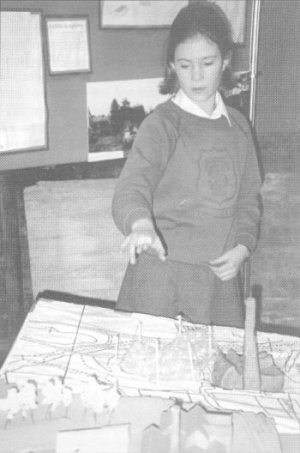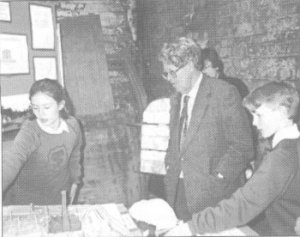Chippindale Venture - TrustNews Summer 1998
The Chippindale Venture is an exciting environmental education project, set up by the Winchester Preservation Trust's Urban Studies Group, itself founded by the late Frank Chippindale. Frank, formerly Head of Architecture at Leeds University, had the idea of involving primary and secondary pupils in design, through the participation of architects, planners and landscape architect.
PROJECT 1998

Drawing of Pumping Station by Keith Leaman
DESIGN FOR HERITAGE CENTRE AT TWYFORD WATER PUMPING STATION
In February pupils from four Primary Schools St Faith's, Twyford, Owslebury, and Compton presented their approach to designs for a Heritage Centre at the rural pumping station at Twyford.
For four weeks on Tuesday afternoons they had been working in groups of five, each with the support of an architect or landscape architect.
Ideas from the children were matched by their skills in presentation, both visual and oral, which embraced many areas of the curriculum written work, drawings and three dimensional models on display; evidence of the use of numbers in calculations of area, volume and distance; appreciation of the forces of energy and the use of materials in the industrial processes at the works as well as materials for use in the existing buildings and the structures they proposed.
Techniques used by architects (for example how relationships between rooms and spaces can be shown in the form of a 'bubble diagram" before arriving at a layout plan and section) were grasped enthusiastically and recorded in the design sketches.
The process was shown to be as important as the end product of a building design. Presentation to an audience of one hundred or so was coped with skilfully. Some young people had clear marketing skills and were persuasive in their arguments.
Imagination had been allowed to run free and then to address realities. Every group was aware of the need for access by people of all ages and degrees of mobility. The challenge of car parking was addressed.
Members of the Twyford Waterworks Trust, present at the Village Hall event, were impressed with the range of concepts and designs, more modern than ancient, and how readily their working monument could be enhanced with new structures, many with an engineering spirit to them. Steam and other power, the lime production and the provision of drinking water as well as the Victorian, Edwardian and later buildings had certainly inspired the learning of the children, and their own efforts were an education for the adults.
Historic Background
For nearly a hundred years, drinking water for the villages around Twyford has been pumped from deep wells under Hazeley Down.
Southern Water Services use only a small part of the buildings for pumping, using electricity, and chemical treatment of the water before it is piped to local reservoirs for storage.
The land and buildings, including the disused lime kilns, and the chalk quarry, are an Ancient Monument.
In the existing buildings there is a collection of engines:
pumping engine
steam engines
hydraulic engines
diesel engines
gas making plant
petrol gas engine
DESIGN BRIEF FOR THE WORKING GROUPS

Presentation by a Twyford Pupil
How this project was approached with the pupils
The brief to the pupils (9 year olds) began as follows: What we can see at Twyford.
First you will describe the existing buildings and how they are positioned on the different levels of the site.
You will note the trees and chalk grassland, and see the plant machinery.
The chalk waste from the water softening process (that which was not used by Eucryl for toothpaste) was dumped on the north side of Hazeley Road. The high bank is now covered with birch trees, behind which was recently built a water bottling plant.
You will also look at the spaces in the buildings, the exhibits, lavatories and kitchen / messroom. Imagine how they are used when open to the public on Open Days.
PURPOSE:
A HERITAGE CENTRE for the interpretation of the Ancient Monument and its setting; for telling the story of drinking water to display water pipes and pumps, water treatment and bathroom and kitchen fittings.
WHAT DID THE ADULTS GAIN?
The built environment professionals have found it stimulating to work with children, and have banished outdated perceptions of education based on their own experiences. In having to explain their professional roles they had to think about and evaluate their own practices. The planners found it stimulating to see children's schemes "uncontaminated by the bureaucratic process".
They all learnt that although they might be experts they did not have all the answers.

One of the models by Twyford pupils. Photo by Pam Moore
Benefits flow in two directions - to those in education and to the design professionals.
For the pupils and students there is an awakening of interest in architecture, buildings, spaces, places ( urban design ), landscape, construction, materials and design decision processes. Built Environment Education (BEE), involves "experiencing, understanding and shaping place".
BEE is part of Environmental Education, a cross-curricular theme, through which pupils develop skills of co-operation, communication, handling data, problem solving, decision making, questioning, observing and making.
Active learning approaches include brainstorming, ranking, surveys, photography, visits, interviewing, research, and map work as well as design. Children's vocabulary can be expanded.
Through classwork and outdoor experiences the "attainment targets" and "programmes of study" of the statutory National Curriculum can be delivered effectively, even when the normal timetable is suspended. There are strong linkages with the Design and Technology curriculum and with Art. Geography and History require a knowledge and understanding of places and buildings.
There is much scope for English language expression and use of Mathematics, even Music and Drama. Methods of questioning are akin to the "detective work" of Science and to the techniques of Personal and Social Education - another cross-curricular strand. ( Others are Careers, Citizenship, Economic and Industrial Understanding, Health Education - all of which resonate in connections with BEE).

Two pupils from Twyford Primary saw the pumping engine in steam
and were delighted as Lord Briggs to engage in conversation
with him about the design project
Relationships between adults and children, collaboration, awareness of values and attitudes of others, responses and behaviour can be stimulated by designers working with teams of children or students.
Presentation to other pupils, parents, governors and local councillors involves public speaking, describing the design / decision making process and demonstrating the results with three dimensional models, drawings, diagrams, poems, and other written work. This echoes the skills of architects and designers - whose own training and practice uses such techniques.
Sometimes a student will consider architecture, planning or design as a career option. Many of the children will be future clients, as users or as managers / patrons of the built environment.
Those who have been part of a Chippindale Venture will be better informed, possibly more sympathetic both to the environment and to the designers of its future.
"Environmental education is partly about generating environmentally aware citizens of the future, but it should never be forgotten that environmental education can show young people that they have a valuable contribution to make today, that their actions and opinions matter."
Nigel Green, Winchester 1993 unpublished - Analysis of a unique environmental education project
For this project other sponsorship has included donated time of the many architects and allied professionals who worked in the schools, and materials in kind from Countryside and Environmental Planning, of Winchester. Hampshire County Architects provided a contour model.
This Chippindale Venture was organised by Phil Turner, planner in private practice and former director of the Twyford Waterworks Trust, with assistance from Deane Clark, Architect and Director/Clerk of the Works. Other Waterworks Directors who assisted included Charlie Simpson and Pam Moore, also the administrator of the Chippindale Venture.
Asa Briggs recalled that he and Frank Chippindale were contemporaries on the staff of Leeds University.
Other working attractions are open to visitors on the Open Days in May and October each year (and other weekends during the summer months).
